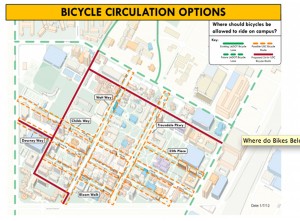Consultants present plans for designated bike lanes on campus
The Office of Student Affairs and the consultant team for the USC Bicycle Master Plan presented a review of the planning process Thursday and outlined proposed solutions to bicycle congestion on campus, which includes the designation of specific bike lanes on campus.
Alison Kendall, a principle architect at Kendall Planning + Design, a firm hired in October to work with Student Affairs and the Dept. of Public Safety to help solve the ongoing issues related to bikes, spoke at the event held at Tommy’s Place.

Proposed bike plans would create designated bike lanes along Trousdale Parkway, Downey Way and McClintock Avenue. | Photo courtesy of USC
“Basically, what we began is a systematic approach to looking at bikes on campus,” Kendall said. “Our general concept is to have certain roadways on campus that are marked by direction where it is safe [to ride a bike].”
Twenty-five percent of undergraduates have had a collision with a bicycle within the last year, Kendall said.
To increase safety on campus, the consultants suggest that separate bike lanes be created on all major roadways on campus, including McClintock Avenue, Trousdale Parkway, Downey Way and 34th Street.
“While not wanting to be overly restrictive, there is obviously a need to regulate,” Kendall said. “We need to develop a progressive enforcement approach.”
Consultants also presented plans to add more secure bike racks around campus, bike repair and services centers and a bike sharing and rental program as an alternative to owning a bike.
Kendall Planning + Design spoke to students and faculty , including 20 student and staff organizations, about the bike issues, and reviewed accident data involving bicycles on campus. The firm also looked at other universities, such as Stanford University that have implemented bike safety programs on their campuses.
About 200 people provided their input at the first bike summit on Jan. 18, and 2,000 people responded to an online survey about the bikes.
Consultants on the project also determined that most cyclists at USC are inexperienced.
“Many undergrad cyclists had never really biked before,” Kendall said. “As a result, they have a very limited understanding of how to bike in an urban setting.”
To remedy this issue, Kendall Planning + Design has suggested a program to educate cyclists at USC, which would potentially include classes on safety, bike tours around campus, videos offering biking tips and outreach from groups such as peer health educators, residential advisers and DPS.
Tom Studdert, director of orientation programs, said none of these plans have been finalized. USC administrators are set to discuss the plan at their meeting in early May.
“From there, an implementation plan will be developed. It’s not just an overnight process,” Studdert said.
Deike Peters, an adjunct assistant professor of urban planning, and graduate students from a Bike Planning Studio course in the Sol Price School of Public Policy also presented their specific research material and suggestions at the event. The students worked closely with Kendall Planning + Design on the project.

I’m glad USC has finally come to their senses by asking Stanford for help.
I’m kind of confused by the map. It looks like pretty much every path on campus is designated as “possible”. This indecision is inexcusable; this ain’t rocket science.
I think it’s inevitable that in the future the school will have more bikes on campus than it does today. The USC campus is ideal for cyclists, with generally dry weather and flat topography. Bike accidents need to be better prevented, especially when pedestrians are the victims, but this solution is half-baked.
All those “possible” paths should be made permanent. Moreover, the actual bike paths need to be clearly separated from pedestrian paths. Just do a Google Street View of Amsterdam (or anywhere in the Netherlands for that matter, including industrial zones) to see how this should look. Ideally the bike path will be slightly submerged and a different color than the pedestrian path.
My discussions with DPS have exposed a not too subtle contempt on their behalf towards bikes (perhaps they should get rid of their segway/chariots and commit to bicycles themselves). Beyond the paths, all buildings on campus need to better incorporate parking spots for bikes. Whereas the southeastern corner of campus doesn’t have a crowding issue, the center and northwest corner surely do.
It’s great news that the school is addressing the bicycle issue but I fear the conclusions seem to skirt the heart of the matter. Without encouraging bicycles more, the DPS contempt of bikes will persist.